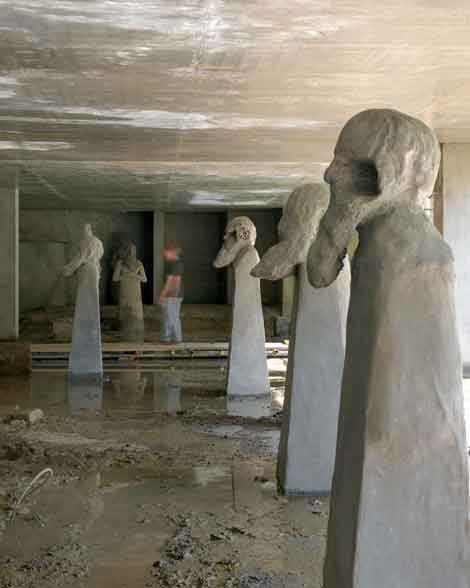London has an ancient history. Londinium was established on the current site of the City of London around 43 AD and served as a major commercial center for the Roman Empire. Since then it’s grown like layers of alluvial rock to create a complex palimpsest that from time to time throws up tantalizing clues to our past and the rich mix that has made us who we are. Digging up the road to mend a gas leak is liable to reveal a Mithras shrine, Roman foundations or shards of medieval glass.
Now an empty wasteland site behind University College Hospital just off Tottenham Court Road has been taken over by the British-Israeli sculptor Daniel Silver. In conjunction with the innovative commissioning agency, Artangel, which was behind such inspired projects as Rachel Whiteread’s legendary House (1993)—a concrete cast of the inside of an entire Victorian terraced dwelling exhibited at the location of the original house, 193 Grove Road, in the East End of London—Silver has created “Dig.”
In a concrete shell, overgrown with buddleia and horsetail, that feels like the sort of disused car park where nasty things happen in gangster movies, there appears to be evidence of some kind of archaeological dig. Entering over rickety duckboards we come upon a series of wooden trestle tables where rough mud, marble and terra cotta figures have been laid out in rows as if to be classified. Are they the remains of some ancient civilization or part of some forgotten fertility rite? What are they doing here and who made them? Were sacrifices and offerings once made to propitiate these apparent gods?
There are busts of bearded men with a philosophical mien and women with the sort of elaborate hairdos found on archaic Cycladian figurines, as well as a many-breasted goddess reminiscent of Diana, the goddess of the Ephesians, and a priapic hairy faun. Some of the figures are deformed or eroded as if by time or plunder, others are no more than broken shards. Marble fragments—possibly a foot or an elbow—lie apparently waiting to be reunited with some implied whole. On a subterranean level, arrived at by makeshift scaffolding steps, larger figures stand on concrete plinths in nooks and crannies amid a bed of muddy green sludge. The day I went it was raining and the constant drip of water made the place seem like a lost sacred spring.
Fascinated by Sigmund Freud’s collection of archaic sculptures, Silver ponders on what it is we choose to reveal and what secrets or phobias remain hidden and forgotten. Archaeology is a way of understanding the past through objects but it also acts as an apt metaphor for delving into the subconscious. The installation seems to imply that in a secular society, belief systems are no longer cohesive and that doubt and uncertainty, rather than faith, are the default positions. By implication these fragments and totems invite us to question what remains when the meaning and significance of religious rites and rituals have been lost in the mists of time and all that is left is a cluster of shards. You can’t help wondering what future generations will make of our own icons and detritus. How we will be understood by archaeological digs several centuries on.
Though born in London in 1972, Silver was raised in Jerusalem, a city that itself is a kind of historical collage. His background is complex with migrations between Israel, London and South Africa that have led him to feel, like many of Jewish descent, rather homeless. The work suggests that a quest for roots and meaning is hardwired into the human psyche.
Silver’s approach to sculpture is idiosyncratic. There’s something impulsive and childlike about it, regressive and scatological. Though if one looks carefully it’s possible to see the influence not only of archaic and Greek sculpture but of Easter Island figures, the Chinese terra cotta warriors of Xian, of Picasso and Rodin, as well as Anthony Gormley’s “Field for the British Isles” (1993)—that carpet of thousands of little clay figures that filled gallery spaces like a Lilliputian army. But more than anything “Dig” suggests the human need to make totems and artifacts that tell us who we are and how there is an essential thread that links those who lived in the past with those of us living in the present.


